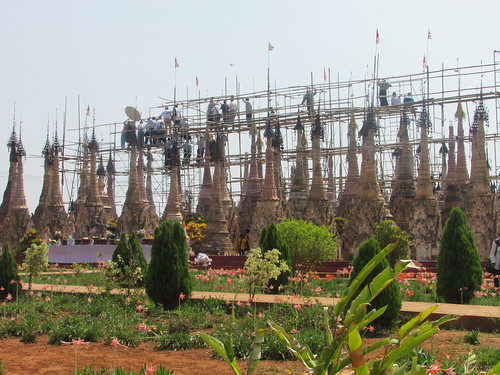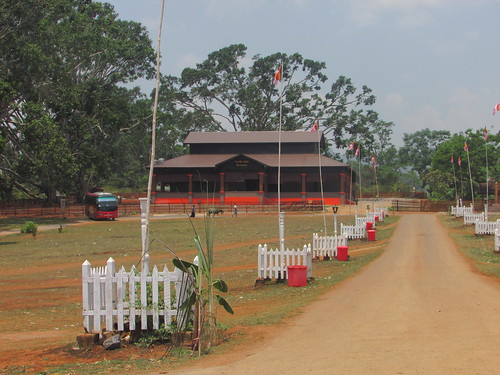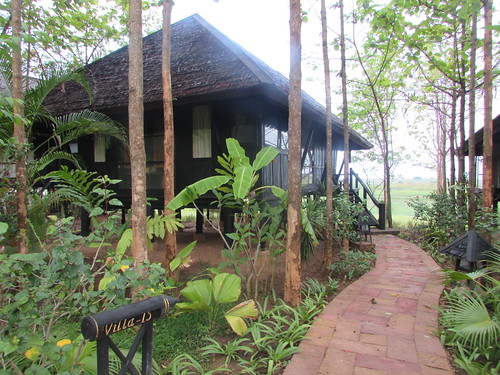My hotel, Villa Inle Resort and Spa was very comfortable and peaceful, so I awoke refreshed although during the night there had been a violent thunderstorm followed by torrential rain. Monday was planned for a visit to Kakku: an important Buddhist site with over 2,000 pagodas.
My first visit to Inle Lake in 2008 (part of the 'Far East Two' trip, described here) had included a trip to Kakku during which there was heavy rain whilst I was touring the pagodas. That earlier trip is described here.
This time, I was picked up by car from my hotel. As I've noted already, there are road improvements in many areas and the Pa-O area of Southern Shan State where Inle Lake located is no exception. I was told we could now drive on a new road from Maing Tauk Village (the location of the hotel) cross country to Kakku, with a considerable saving in time. Previously it was necessary to go via Nyaung Shwe (where I'd boarded the boat to the hotel the previous afternoon) and Taung Gyi to reach Kakku.
We set off about 8.45 a.m. and headed south, close to the eastern side of Lake Inle. Tourism has brought ribbon development which extends ever-further. The Government have designated a 'Hotel Zone' to control this development. Feeder roads, complete with lighting, are in place and large, new hotels are open or being built. I noticed the 'Hotel Zone Jetty' under construction.

Inle Garden Hotel in the Hotel Zone.
Our route then took us through the mountains on a road not long opened, presumably to help open up the fairly remote area we were in. A rural, agrarian way of life was the norm and the majority of the people showed their Pa-O origins with either a turban for the men or an orange plaid headscarf for the women, who favoured dark-coloured clothing or the traditional black tunic and trousers.

Kakku by road (2017): Following a pick-up with traditionally-dressed Pa-O people as they pass a herd of cows.
Sooner than I expected, we were at Kakku and the remarkable sight of (I'm told) 2,478 pagodas huddled together on a compact, vaguely rectangular site around 300 metres by 150 metres set on a gentle hillside. As a foreigner, an admission payment was made for me.

The Pagodas of Kakku.
Thandar Oo said that a party of donors from Yangon were dedicating a number of donated 'hti' that morning. The 'hti' or umbrella is the metallic decoration carried at the top of the 'spire' of a Myanmar-style pagoda (different ethnic groups favour different styles, I understand). Music was coming from the site and the dedication was in progress. Scaffolding had been erected over a row of perhaps eight similar-sized pagodas. The scaffolding was a mixture of conventional steel scaffoldong, push-together metal access towers and bamboo poles, tied together with a heavy-duty twine. One bamboo deck had been laid across the scaffolding about eighteen feet above the ground and a second about twenty four feet above the ground. About twenty four men were distributed across the two decks, presumably the donors or donors' representative. The upper deck of the scaffolding was about level with the position where the 'hti' would be carried.

Kakku: Dedication of donated 'hti'.
I couldn't see the ceremony itself but later the men all returned to ground safely. Immediately, a group of scaffolders started to dismantle the temporary structure.

Kakku: The temporary scaffolding for the dedication ceremony can be seen on the left, topped with a number of Buddhist flags.
A combination of bad storms and last year's earthquake has damaged pagodas throughout Myanmar. The 'hti' can easily be displaced and many at Kakku were sitting at a crazy angle. The delicate, tapering pinnacle or 'spire' of brick, sometimes with stucco applied, is the next area to crumble. Damage elsewhere in the structure is usually limited to cracks developing or small areas of brickwork or stucco detaching.

Kakku: An elaborately-decorated pagoda with a displaced 'hti'.
Restoration work is always going on, but this is usually at the behest of donors and to the despair of archaeologists who often consider the historical record 'corrupted' by the new work.
Pagoda builders and those carrying out repairs seem to use bamboo scaffolding exclusively, embracing the pagoda being worked on in a 'cocoon' of scaffolding and we saw examples on our visit to Kakku.

Kakku: Restoration work in progress on a pagoda.
The railway station at Kakku didn't detain us long. It is a one-platform halt on the single line from Taung Gyi to Nansen and Mong Nai. Although it has a simple station building, we found it boarded-up and semi-derelict. There is one train to Taung Gyi at 06:00 daily, arriving three hours later. The return from Taung Gyi is due to arrive in Kakku at 16:00. Ordinary Class Single Fare is 200 Kyats.

Kakku Station: With my guide and driver.
The restaurant just opposite the pagoda site with a timber framed roof which I used back in 2008 was badly damaged in storms. It has been replaced with a huge steel-framed affair, very well-appointed and clean so we were able to enjoy lunch there.

Kakku: Hlaing Konn Pa-O National Restaurant.
After lunch, we set off on the return journey through the mountains using the new road. Back at Villa Inle, I was able to enjoy the warm afternoon in the comfort of my own villa.

Villa Inle Resort and Spa: My Villa.
Tomorrow morning we plan to explore Inle Lake a little then, in the afternoon, I catch a flight from Heho back to Yangon.
Related Posts on this Website
Next Post describing this trip.
All Burma-2017 Trip posts.
My Pictures
Where necessary, clicking on an image above will display an 'uncropped' view or, alternately, pictures from may be selected, viewed or downloaded, in various sizes, from the albums listed:-
Kakku by road (2017).
Kakku, Shan State, Myanmar (2008: my earlier pictures).
Villa Inle Resort and Spa.
[Links to pictures added 16-Aug-2017: Text amended, pictures added4-Sep-2017]
